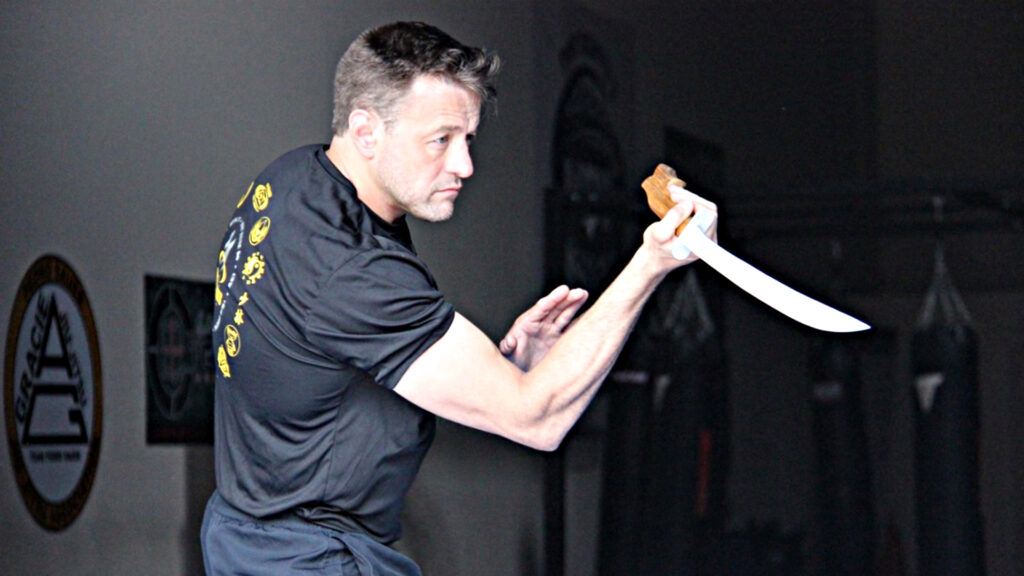
To streamline and emphasize the most effective elements of combat science, I created the Combat Blueprint. The field of martial arts is vast and complex, with numerous techniques and styles that can be overwhelming. The Combat Blueprint serves as a guide to navigating this extensive landscape, helping practitioners maintain focus on the core, high-yield fundamentals. It’s designed to optimize training efficiency by concentrating on what truly impacts skill development and combat effectiveness. Recognizing that our time is precious and a direct reflection of our life, the Blueprint is a tool to ensure we invest our time wisely in our martial arts journey, gaining the most value and progression from every moment spent training.
For those unfamiliar with The Combat Blueprint, it is structured around five fundamental pillars of study, known as Primal Environments. These pillars encompass various aspects of combat and self-defense, including:
- Marksmanship – Focusing on skills related to precision and accuracy in shooting.
- Edged and Blunt Weaponry – This section covers techniques and strategies for using knives, sticks, and urban weapons of Opportunity.
- Striking – Concentrating on various forms of hitting or attacking, such as punches, elbows, and kicks.
- Hand Fighting/Pummeling/Giraffe Wrestling – Emphasizing close-quarters combat, grappling, and controlling techniques.
- Ground – Concentrating on ground-based fighting strategies and maneuvers. (Grappling, Anti-Grappling, Ground Fighting, Dog Boxing, & Grounded Weapon Fighting)
The Blueprint extends beyond just these five pillars; they represent the foundational elements, the starting point of our study. These fundamentals are our initial focus due to their critical role in ensuring success in violent encounters. They lay the groundwork upon which we build more advanced skills and strategies, setting the stage for a comprehensive understanding of combat and self-defense. With the Blueprint, you can craft an intelligent training plan and schedule that ensures a balanced approach to developing both your skills and knowledge. This framework allows for a structured and effective progression in your training, helping you grow uniformly in various aspects of combat and self-defense.
The Art Of The Blade
In this article, I aim to delve deeper into the Edged and Blunt Weaponry pillar of the Blueprint, particularly emphasizing the study of blades. Nowadays, we often carry smaller blades on our person compared to historical norms. However, the study and mastery of the blade have been integral parts of warrior cultures for centuries, extending far beyond mere combat necessity.
Historically, training with blades was not just about preparing for battle. It plays a significant role in a person’s physical and mental development. Regular practice with blades led to enhanced levels of fitness, as it required and built strength, endurance, and agility. Additionally, mastering blade techniques demanded and refined hand-eye coordination, which is crucial in both combat and daily activities.
A significant advantage of this training is the enhancement of footwork and movement skills, which are crucial components of the combat arts. These skills are not only beneficial in blade training but are universally applicable in various combat scenarios. The ability to maneuver effectively, maintain balance, and position oneself strategically are essential skills that can be honed through this training.
Furthermore, the training also focuses on developing the ability to strike with power and precision. In a combative environment, the combination of agile movement and powerful striking can make a substantial difference in the outcome of an encounter. The skills cultivated through this training are vital, whether it’s evading an attack, closing in on an opponent, or executing a decisive strike.
Overall, the improved footwork and movement skills, along with the ability to deliver powerful strikes, are key benefits that contribute to a practitioner’s overall combat effectiveness. This training not only builds physical capabilities but also enhances mental agility and tactical thinking, making it an invaluable part of any comprehensive combat training program.
Moreover, the disciplined study of the blade sharpened mental acuity. It improved cognitive processes such as decision-making, strategy formulation, and focus. This mental training was as vital as physical prowess, contributing to a well-rounded warrior.
Another often overlooked benefit of blade training was its positive impact on joint health. The movements involved in blade work, which range from subtle to dynamic, helped maintain joint flexibility and strength. This aspect of training ensured that practitioners could remain agile and capable well into their later years, highlighting the blade’s role in promoting long-term physical well-being. Based on my experience, I can attest to the advantages of this training for joint health. Having engaged in this training for many years, it has played a pivotal role in maintaining my body’s overall condition. It has not only kept me fit but has also been instrumental in my recovery from significant injuries over time. This personal testament is one of the key reasons blade training is an integral component of the Combat Blueprint.
Running With Scissors
With this in mind, if your current training regimen doesn’t include blade training, it’s time to consider incorporating it. Adding this component to your skillset doesn’t have to be a massive investment, especially if approached intelligently and methodically. It’s essential to acknowledge, however, that where and how you begin this study can significantly impact your learning experience.
Many sources of information on blade training can present an overwhelming curriculum that may seem daunting at first. This feeling is understandable, as most common sources derive from systems rich in content and history. These systems often encompass a vast array of techniques and knowledge, which can be a lot to take in for someone new to the practice.
The key lies in finding the right instructor. A good instructor can distill the vast information down to the essential fundamentals necessary for practical, real-world application. They should be adept at separating the non-essential elements, focusing instead on what is truly effective and relevant. This approach will not only make your learning process more manageable but also more efficient and applicable to real-life situations. Thus, blade training can become a highly valuable and manageable part of your overall martial arts journey with the right guidance.
Effective defense against a threat starts with a profound comprehension of what that threat is and how it might be used against you. In the context of violent encounters, edged weaponry is a frequent reality, whether the assailant brings a weapon or improvises with available objects like a pen or a piece of glass out of necessity. Understanding the dynamics of how these weapons can be wielded is crucial in preparing oneself to respond appropriately and protect against such threats. This knowledge forms the basis for developing effective defense strategies against various edged weapons, regardless of whether they are traditional blades or impromptu sharp objects.
®C-Tac’s Art Of The Blade
This emphasis on the art of the blade is precisely why it’s a key component in our Civilian Tactical Training Association’s ®C-Tac program. Our approach isn’t to cover the extensive systems associated with weaponry, such as Filipino Kali, in their entirety. Instead, we distill the knowledge into the basics necessary for increased effectiveness in potential encounters.
Our training is structured in a way that ingrains instinctive, positive responses into the nervous system. We aim to foster the development of attributes and skills that become second nature to the students, readily available when they need them most. By focusing on the fundamentals, we ensure that our trainees understand the techniques and apply them effectively and reflexively in real-world situations. This methodical approach to blade training makes it a practical and vital part of our comprehensive C-Tac program.
My overarching goal is to expedite the cultivation of the warrior’s mindset and broaden the adoption of the fighter’s mindset worldwide. I am dedicated to developing and offering innovative training and knowledge, equipping individuals to be more adeptly prepared for both the challenges of daily life and the potentiality of violent situations. Furthermore, it is my intention to instill in people the importance of taking responsibility for every facet of their lives, encouraging them to strive for personal excellence and self-reliance rather than depending on others. This philosophy underpins our training approach, ensuring that individuals are not only skilled in martial arts but also empowered in all areas of life, and the C-Tac Association is just one avenue I use to achieve this goal.
In conclusion, the Combat Blueprint is a comprehensive and strategic approach to self-defense training designed to focus on the most effective elements of combat science. By breaking down the vast and complex field of martial arts into five fundamental pillars, the Blueprint provides a structured and efficient path for practitioners to develop critical skills and knowledge in combat and self-defense.
This article has specifically highlighted the importance of the Edged and Blunt Weaponry pillar, particularly the study of blades. As we’ve discussed, blade training is not just about combat readiness; it encompasses physical fitness, mental acuity, agility, and long-term health benefits. These skills are crucial in traditional martial arts and modern, real-world scenarios where edged weapons are a prevalent threat.
Our ®C-Tac program, under the Civilian Tactical Training Association, emphasizes the art of the blade, recognizing its vital role in a well-rounded combat training regimen. By focusing on fundamental techniques and principles, we ensure that our students develop skills that are instinctive, effective, and applicable in various situations. This approach allows practitioners to gain the most from their training time, equipping them with the tools necessary for success in both combative environments and in life.
Whether you’re a seasoned martial artist or just beginning your journey, incorporating blade training into your regimen can be a game-changer. It not only enhances your physical abilities but also sharpens your mental focus and strategic thinking. The Combat Blueprint, emphasizing practical, high-yield fundamentals, is an invaluable resource for anyone seeking to improve their martial arts skills and prepare for the realities of self-defense.
In embracing the art of the blade and the broader principles of the Combat Blueprint, we empower ourselves not just as martial artists but as individuals capable of facing challenges with confidence, skill, and resilience. The journey through self-protection and self-defense is one of continuous learning and growth, and the Combat Blueprint is a guiding light in this ever-evolving landscape.
Shift Your Perspective, Take the Action, Transform Your World.
~ Sifu Alan

Alan Baker is celebrated for his exceptional skill in creating customized Defensive Tactics Programs and his prowess in high-performance coaching. Tailoring his expertise to meet the needs of law enforcement agencies, military groups, and security companies, Alan crafts training curriculums that are grounded in practical techniques, adaptability to real-life scenarios, and intensive, situation-specific exercises. His training methodologies are meticulously designed to elevate the operational effectiveness and situational preparedness of individuals in high-stakes environments. Learn more about Alan’s distinctive programs here.
Beyond his tactical acumen, Alan is also a foremost “mindset” coach, adept at tapping into the untapped potential within individuals. He is particularly attuned to the current societal trend that often overlooks traditional masculinity and the cultivation of strength. Addressing this, Alan champions the development of a warrior spirit — the readiness to confront chaos and take decisive action when necessary. He passionately mentors professionals, entrepreneurs, and individuals on their personal development journeys, focusing on fostering a mindset dedicated to excellence. His coaching is anchored in pragmatic strategies that fortify mental resilience, enhance focus, and stimulate drive. Engaging with Alan sets you on a transformative journey where mental obstacles are overcome, innate strengths are recognized and honed, and your objectives become distinctly attainable. His insights are key in boosting performance and developing a mindset geared for victorious accomplishments.
For a deeper exploration of Alan’s mindset philosophy and his approach to empowering especially men to embrace their strength and resilience, delve into his insightful collection of books. If you’re ready to accelerate your personal and professional growth under Alan’s expert guidance, connect through his official website.
